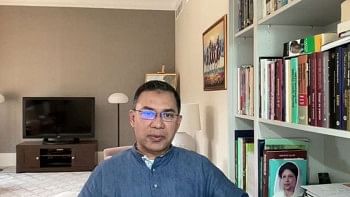Guru Dakshina: Legends through the Eyes of a Disciple

Almost all the readers of this review, I believe, know of the dramatist Momtazuddin Ahmed, National Professor Anisuzzaman or social activist Dr. Anupam Sen. It is a matter of some clicks on your mouse to get to know about these legends from Bangladesh. But, maybe, some of you sympathize with me that you do not know them through the microscopic lens of a student, who were in good terms with these leading lights within the four walls of classrooms and even outside.
Guru Dakshina by Ovik Osman can be considered as a 'book of quarry' for the current and coming generations, providing them with a close view to the lives some Bangladeshi legends lived. Ovik Osman is a poet, dramatist, columnist and essayist at the same time, who wrote almost 16 more books touching different genres of literature so far. Presently, he is serving as a guest lecturer at the Department of Dramatics, University of Chittagong. He was so closely attached with the figures mentioned above that he penetrated the ocean of their thoughts and therefore, successfully delineated them as teachers, intellects, thinkers, writers, but above all, humans.
Osman paid homage to a total of seven of his teachers including his father-Forak Ahmed Chowdhury, alias Forak Master- and three other unsung heroes –linguist Dr. Moniruzzaman, Rita Dutta and Professor Rajib Humayun- who hardly ever got any media attention, implying that their contributions should be made accessible to this generation.
If you google the name Maniruzzaman/Moniruzzaman, I can surmise that you might be confused with several Zamans with the same name. The common search engine results include the poet and lyricist Moniruzzaman and some others from different areas of expertise. Ovik Osman, therefore, has portrayed that Zaman who had brought to light the rich culture and literature of Chattogram. In his masterpiece, "Sahitye O Sangskritite Chattogram" almost all the contributors from the division, known and unknown in literature have got their places along with a list of their significant works. Professor Maniruzzaman used to feel the necessity of preserving era defining literary works of the community outside the capital in order to facilitate a learning environment where the coming generation from remote areas would be able to understand and evaluate them. To quote professor Maniruzzaman, "Chattogram has enriched Bengali literature in many ways. After the due recognition of its punthis, translations and romantic literature, a change of attitude was observed in other writers working on the contemporary history of Bengali literature." Hence, the writer of the book labelled him as the "multi-dimensional Maniruzzaman" for his contributions in linguistics, poetry, lyrics, prose and children's literature, much like the British poet and writer William Radice who in his poem "The Other Army" described his face to be "wall of goodness." The readers will find here then a portrait of the person and the teacher Maniruzzaman alongside his contributions in Bengali literature through the well-written description of one of his close students.
However, Dr. Anupam Sen and Professor Anisuzzaman appears in the book in a completely different way. Social activist Anupam Sen has been portrayed as a poet, a "Shuvro manabikatar kabi" incorporating various subject matters like nature, love, capitalism and modernism, whereas Professor Anisuzzaman is described as an excellent teacher, a humble man with astounding emotional intelligence. Some selected extracts of his speeches delivered at different places have been quoted here as well, through the voices of other renowned writers and academicians like Syed Manzoorul Islam.
Readers will also be able to discover the Natyacharya Momtazuddin Ahmed and Professor Rajib Humayun anew. Ovik Osman has successfully unlocked the life of an experimental playwright during the rise of Bengali nationalism before and after the Liberation War as a person and as a teacher, through his description of the memories of the Department of Bengali (Chattogram College)- of which he was an Honours student, Bangla Sangshad- of which he was AGS staging Momtazuddin's drama at the historical Laldighi Field, and so on. Ahmed's thoughts of drama and its changes from ancient to modern period will briefly be found in the book.
The writer, however had the friendliest relationship with the Professor and linguist Rajib Humayun, founder of Dhaka University Linguistics Department. As described in the book, being well-versed in the genres of prose and plays, Humayun's remarkable contributions include his research on the language and culture of Sandwip island and publication of some books on the same. On a related note, one could suggest that the writer could have gone deeper and unearth his philosophical thoughts even more, as Ahmed Sofa did in his Joddopi Amar Guru in respect to Professor Abdur Razzak.
Ovik Osman's tributes to his father Forak Ahmed and higher secondary level's teacher Rita Dutta are more well-knitted with appropriate diction. Rita Dutta has been depicted through his experience as a student in Intermediate College and her quotes and thoughts about the Liberation War, religion, country, and so on in many of her write-ups in different magazines and newspapers.
A problematic aspect of the book, however, is that Osman seemed to be somewhat in a hurry to develop the contents and input regarding the necessary information to be portrayed the book. The book itself is attractively designed and produced, but it could have been more elaborative and in places better edited and proof-read to avoid some unexpected spelling mistakes. All in all, a commendable effort was made on the part of the writer, which illuminates us about the lives of some Bangladeshi intellects in a perspective never seen before.
The writer is National Consultant, UNDP Bangladesh.


 For all latest news, follow The Daily Star's Google News channel.
For all latest news, follow The Daily Star's Google News channel. 



Comments